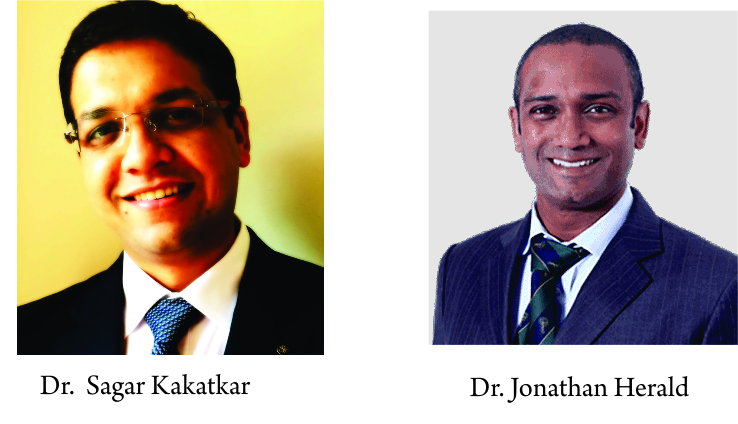Sagar Vivek Kakatkar, Jonathan Herald
Volume 2 | Issue 1 | Jan – Apr 2017 | Page 3-6
Author: Sagar Vivek Kakatkar [1,2], Jonathan Herald [1]
[1] Vivaan Clinic, Nashik, Maharashtra, India.
[2] Dr. VPMCH, Nashik, Maharashtra, India.
[3] Orthoclinic, Sydney, Australia.
Address of Correspondence
Vivaan Clinic, First floor, N.S.B. center, Canada Corner, Nashik
Email: drsagarkakatkar@gmail.com
Abstract
Patho-anatomy and patho-mechanics form the basis of management of any pathology. Gleno-humeral joint is one of the most functionally complex joint in the body because of its greater range of motion and interrelationship of the forces acting on the joint. All these factors should be considered when planning the management of the glenohumeral instability since inability to address anatomical deficiencies may lead to failure; which may further complicate the treatment. The static and dynamic stabilizers of the glenohumeral joint have been described here in relation to the shoulder instability.
Keywords: Glenohumeral instability, pathoanatomy, pathomechanics, inferior glenohumeral ligament.
References
1. Bost FC, Inman VT. The pathological changes in recurrent dislocation of the shoulder. J Bone Joint Surg Am 1942;24(3):595.
2. Codman EA. The Shoulder. Boston: Thomas Todd; 1934.
3. Steindler A. Kinesiology of the Human Body Under Normal and Pathological Conditions. Springfield, IL: Charles C Thomas; 1955.
4. Sugaya H, Moriishi J, Dohi M, Kon Y, Tsuchiya A. Glenoid rim morphology in recurrent anterior glenohumeral instability. J Bone Joint Surg Am 2003;85-A(5):878-884.
5. Griffith JF, Antonio GE, Tong CW, Ming CK. Anterior shoulder dislocation: Quantification of glenoid bone loss with CT. AJR Am J Roentgenol 2003;180(5):1423-1430.
6. Gerber C, Nyffeler RW. Classification of glenohumeral joint instability. Clin Orthop Relat Res 2002;400:65-76.
7. Itoi E, Lee SB, Berglund LJ, Berge LL, An KN. The effect of a glenoid defect on anteroinferior stability of the shoulder after Bankart repair: A cadaveric study. J Bone Joint Surg Am 2000;82(1):35-46.
8. Lo IK, Parten PM, Burkhart SS. The inverted pear glenoid: An indicator of significant glenoid bone loss. Arthroscopy 2004;20(2):169-740.
9. Miniaci A, Berlet G. Recurrent anterior instability following failed surgical repair: Allograft reconstruction of large humeral head defects. J Bone Joint Surg Br 2001;83 Suppl 1:19-20.
10. Bühler M, Gerber C. Shoulder instability related to epileptic seizures. J Shoulder Elbow Surg 2002;11(4):339-344.
11. Burkhart SS, De Beer JF. Traumatic glenohumeral bone defects and their relationship to failure of arthroscopic Bankart repairs: Significance of the inverted-pear glenoid and the humeral engaging Hill-Sachs lesion. Arthroscopy 2000;16(7):677-694.
12. Rodosky MW, Harner CD, Fu FH. The role of the long head of the biceps muscle and superior glenoid labrum in anterior stability of the shoulder. Am J Sports Med 1994;22(1):121-130.
13. Lippitt S, Matsen F. Mechanisms of glenohumeral joint stability. Clin Orthop Relat Res 1993;291:20-28.
14. Halder AM, Kuhl SG, Zobitz ME, Larson D, An KN. Effects of the glenoid labrum and glenohumeral abduction on stability of the shoulder joint through concavity-compression: An in vitro study. J Bone Joint Surg Am 2001;83-A(7):1062-1069.
15. Habermeyer P, Schuller U, Wiedemann E. The intra-articular pressure of the shoulder: An experimental study on the role of the glenoid labrum in stabilizing the joint. Arthroscopy 1992;8(2):166-172.
16. O’Brien SJ, Neves MC, Arnoczky SP, Rozbruck SR, Dicarlo EF, Warren RF, et al. The anatomy and histology of the inferior glenohumeral ligament complex of the shoulder. Am J Sports Med 1990;18(5):449-456.
17. Ticker JB, Flatow EL, Pawluk RJ, Soslowsky LJ, Ratcliffe A, Arnoczky SP, et al. The inferior glenohumeral ligament: A correlative investigation. J Shoulder Elbow Surg 2006;15(6):665-674.
18. Gohlke F, Essigkrug B, Schmitz F. The pattern of the collagen fiber bundles of the capsule of the glenohumeral joint. J Shoulder Elbow Surg 1994;3(3):111-128.
19. Ticker JB, Bigliani LU, Soslowsky LJ, Pawluk RJ, Flatow EL, Mow VC. Viscoelastic and geometric properties of the inferior glenohumeral ligament. Orthop Trans 1992;16:304-305.
20. Bigliani LU, Pollock RG, Soslowsky LJ, Flatow EL, Pawluk RJ, Mow VC. Tensile properties of the inferior glenohumeral ligament. J Orthop Res 1992;10(2):187-197.
21. Savoie FH 3rd, Holt MS, Field LD, Ramsey JR. Arthroscopic management of posterior instability: Evolution of technique and results. Arthroscopy 2008;24(4):389-396.
22. Sugalski MT, Wiater JM, Levine WN, Bigliani LU. An anatomic study of the humeral insertion of the inferior glenohumeral capsule. J Shoulder Elbow Surg 2005;14(1):91-95.
23. Warner JJ, Lephart S, Fu FH. Role of proprioception in pathoetiology of shoulder instability. Clin Orthop Relat Res 1996;330:35-39.
24. Lephart SM, Warner JJ, Borsa PA, Fu FH. Proprioception of the shoulder joint in healthy, unstable, and surgically repaired shoulders. J Shoulder Elbow Surg 1994;3(6):371-380.
25. Pötzl W, Thorwesten L, Götze C, Garmann S, Steinbeck J. Proprioception of the shoulder joint after surgical repair for instability: A long-term follow-up study. Am J Sports Med 2004;32(2):425-430.
26. Zuckerman JD, Gallagher MA, Cuomo F, Rokito A. The effect of instability and subsequent anterior shoulder repair on proprioceptive ability. J Shoulder Elbow Surg 2003;12(2):105-109.
| How to Cite this article:. Kakatkar SV, Herald J. Patho-anatomy and Patho-mechanics of Glenohumeral Instability. Asian Journal of Arthroscopy Jan – April 2017;2(1):3-6. |



